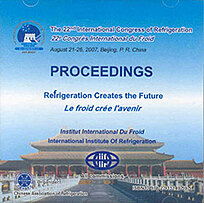
Document IIF
Classification d'écoulements diphasiques horizontaux utilisant des supports vectoriels avec des signaux de capacitance.
Classification of horizontal two-phase flow using support vector machines with capacitance signals.
Auteurs : CANIÈRE H., BAUWENS B., T'JOEN C., et al.
Résumé
Flow regime prediction in air-conditioning units is of great importance for designing evaporator and condensers coils. Most current heat transfer and pressure drop predictions for two-phase flow lack accuracy mainly due to the ignorance of the effect of the flow regime. Because pressure drop and heat transfer are strongly related to two-phase flow regimes, objective and reliable flow pattern maps are needed as a strong basis. Therefore a capacitance sensor was developed for objective flow pattern identification based on the difference in dielectric constant of the vapour and liquid phase. The sensor was tested for air-water flow. Flow patterns were verified using high-speed digital video images. A multivariate analysis with many signal processing parameters was made for investigating the classification potential. A support vector machine was then built based on suitable parameters in amplitude and time domain, in order to statistically classify two-phase flows. A cross-accuracy of 92% was achieved and misclassification only occurs near flow regime transitions.
Documents disponibles
Format PDF
Pages : ICR07-B1-161
Disponible
Prix public
20 €
Prix membre*
Gratuit
* meilleur tarif applicable selon le type d'adhésion (voir le détail des avantages des adhésions individuelles et collectives)
Détails
- Titre original : Classification of horizontal two-phase flow using support vector machines with capacitance signals.
- Identifiant de la fiche : 2008-0077
- Langues : Anglais
- Source : ICR 2007. Refrigeration Creates the Future. Proceedings of the 22nd IIR International Congress of Refrigeration.
- Date d'édition : 21/08/2007
Liens
Voir d'autres communications du même compte rendu (839)
Voir le compte rendu de la conférence
Indexation
-
Experimental study of two-phase adiabatic flow ...
- Auteurs : POGGI F., MACCHI-TEJEDA H., MARECHAL A., et al.
- Date : 21/08/2007
- Langues : Anglais
- Source : ICR 2007. Refrigeration Creates the Future. Proceedings of the 22nd IIR International Congress of Refrigeration.
- Formats : PDF
Voir la fiche
-
TPX for in-orbit demonstration of two-phase hea...
- Auteurs : DELIL A. A. M., HEEMSKERK J. F., MASTENBROEK O., DUBOIS M., OOST S. van, COESEL M. J. N., SUPPER W., ACETI R.
- Date : 10/07/1995
- Langues : Anglais
Voir la fiche
-
Heat and mass transfer processes in connected s...
- Auteurs : SCIVER S. W. van, HUANG X., PANEK J.
- Date : 11/1997
- Langues : Anglais
Voir la fiche
-
Two-phase flow dynamic instabilities in a horiz...
- Auteurs : KAKAÇ S., CAO L.
- Date : 07/06/1999
- Langues : Anglais
- Source : Proceedings of the international workshop on non-compression refrigeration and cooling.
Voir la fiche
-
Probabilistic determination of two-phase flow r...
- Auteurs : JASSIM E. W., NEWELL T. A., CHATO J. C.
- Date : 17/07/2006
- Langues : Anglais
- Source : 2006 Purdue Conferences. 18th International Compressor Engineering Conference at Purdue & 11th International Refrigeration and Air-Conditioning Conference at Purdue [CD-ROM].
- Formats : PDF
Voir la fiche
